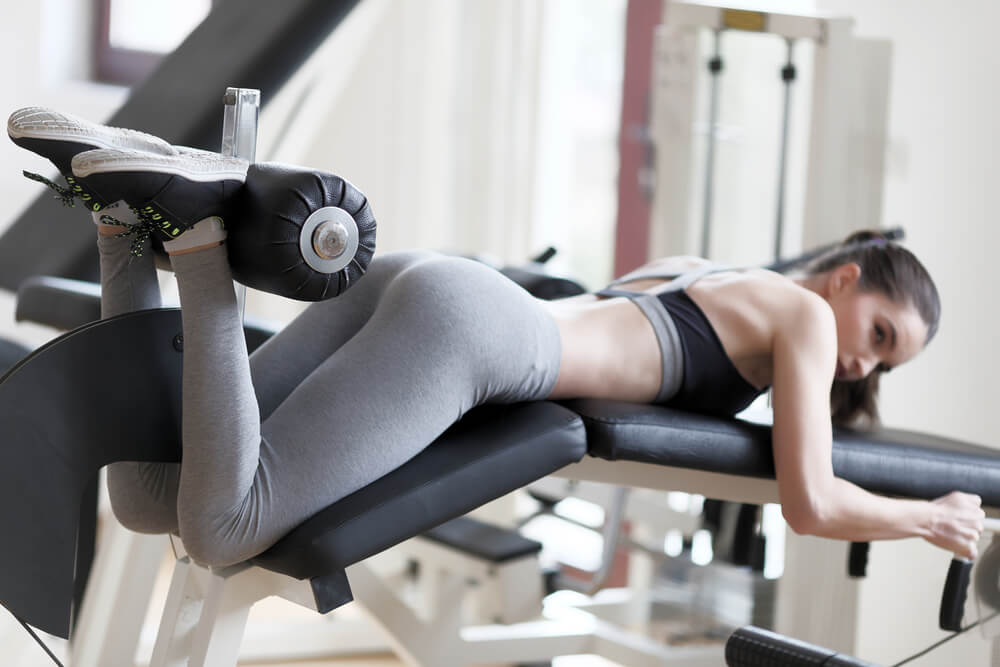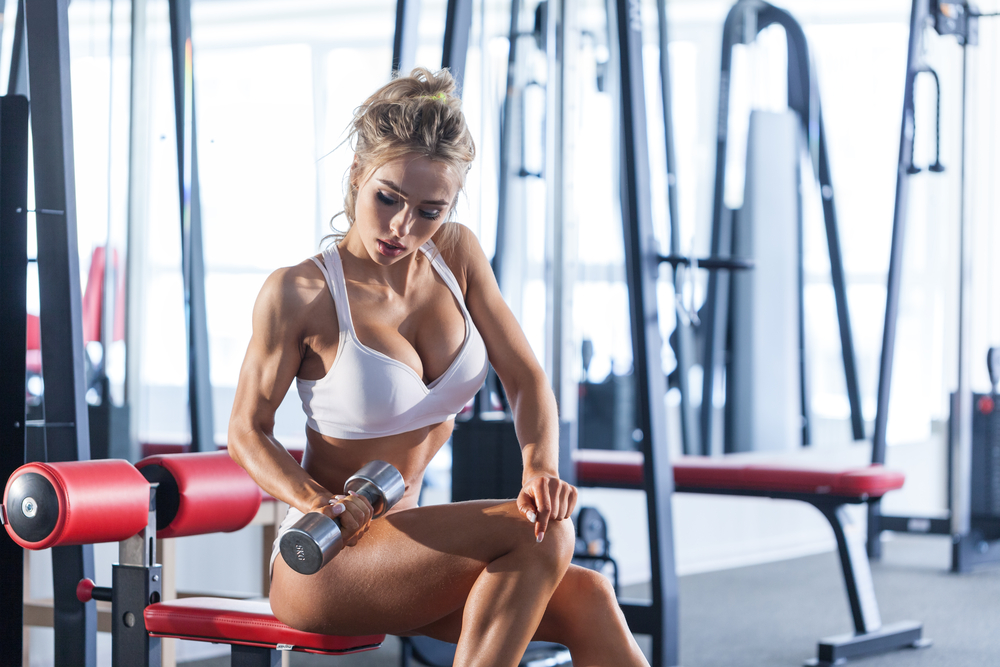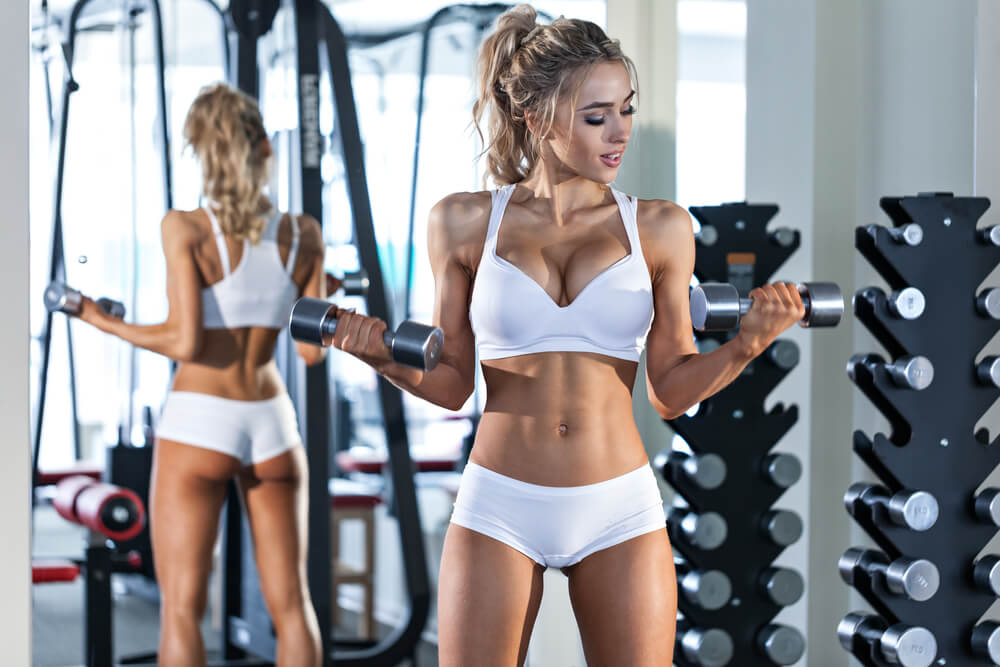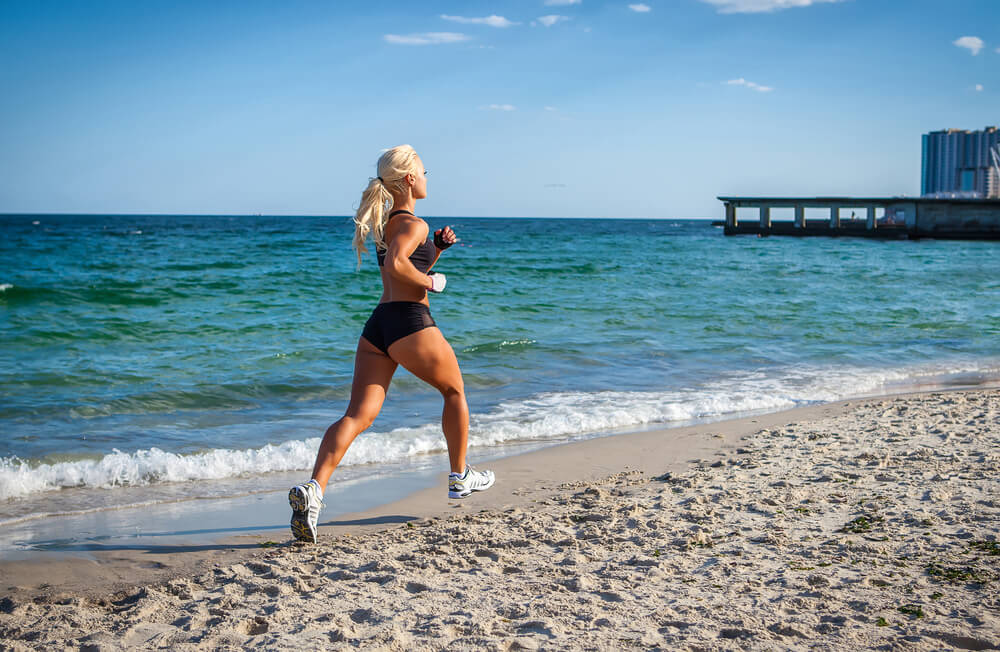
Not sure what to do in the gym? We’ve got you covered. We have all the workout routines for women you need to reach almost any goal you may have. You’re welcome!
Ladies, this one’s for you. It can be intimidating walking into a gym and being surrounded by hardcore guys lifting more weight than you thought was humanly possible. Add to that the standard gym attire in today’s society (yoga pants and tank top seem to be the norm in a lot of places, but you’d know better than I would) and that it used to be frowned upon for women to lift more than soup cans and you have a recipe for feeling embarrassed. However, the hardcore dudes you probably find most intimidating, are so absorbed in their own workouts they likely won’t even notice you.
These guys are probably the nicest and will help you out the most. It’s tough to walk up to a random person, a complete stranger, and ask for advice, at least for the first time. The purpose of this is to provide you with a definitive guide for things that are safe, easy and effective for you without having to walk up to anyone or paying exorbitant amounts of money for a trainer – so you can leave the headphones in and ignore the trainers trying to prospect you.
Time to get down to business.
Common Myths
Think lifting weights will make you look bulky?
Think again.
In order to truly build a lot of muscle, you need testosterone and lots of it.
The female bodybuilders you see that are truly big and bulky you can say with certainty are either taking some extracurriculars (meaning testosterone and human growth hormone, both essential for building muscle) or have been training for a ridiculously long time (10+ years consistently). The average male has anywhere from 15 to 20 times more testosterone than the average woman, so you don’t have to worry about getting big.
Furthermore, lift heavy!
Training for strength (heavy weights, three to five reps per set) is what will prevent injury long term and accentuate your curves. The misconception is that lifting heavy will build big muscles. While it does build muscle, it doesn’t build nearly as much as a high volume routine will (think four sets per exercise, 8 to 12 reps). Hate to break it to you, but lifting light (15 to 20 reps per set) is pretty much useless.
Another term I heard a lot as a trainer was the word “tone.” To me, this refers to the resting potential of your muscles. In English, your muscles have a slightly negative electrical charge to them while you’re not moving because of different substances that they need to contract. I prefer using the word “definition.”
However, when it comes to definition or tone, you can’t do either of those things without a little bit of muscular size, and beyond that it’s about getting leaner, and the most effective way to do that is to lift weights. The heavier you lift, the more fat you will burn, and the more defined you become even if your muscles don’t get any bigger. Also, paying attention to what you’re eating can help out with that even more.

What’s Your Goal?
When I was a trainer, doing consults was probably the most challenging thing, especially with women.
What I did learn, however, was how to get an answer, and I used a method when sending initial emails – I told them to come in with a S.M.A.R.T. goal, which stands for Specific, Measurable, Attainable, Realistic, and Time-Bound.
For example, a S.M.A.R.T. goal would be: “I’m a size 6 now, and I want to be able to fit into a size 4 by the time of my wedding, which is in four months.” It’s specific (size), measurable (again, the size), attainable (dropping two sizes is easy, with dedication and effort) and time-bound (four months until the wedding to do it).
So what’s your goal?
Is it appearance based?
Do you just want to feel better (spoiler alert: Not a good goal)? Do you want to compete in a figure show, powerlifting or Olympic lifting competition? I’ll cover all those goals.
Appearance-Based Goals
Without fail, every woman I’ve ever worked with has wanted a nicer (meaning apple-shaped) butt. To get there, you have to squat or do some variation – there’s no way around it. The second most popular appearance-based goal was to have nicer shoulders – in a sense, better posture. I got to sneak in the important stuff and disguise it as shoulder work.
So here’s a program that will get you both of those things. Three days a week, the workouts will take you less than an hour each. On your off days (the days you don’t lift), 20 minutes of cardio is good, but don’t overdo it – meaning stop at 20 minutes. Definitely take one or two days off completely, where you don’t do any exercise at all.
Directions: Perform moves labeled “a” first, “b” second and so on. Complete all prescribed sets and reps before moving on to the next grouping. Rest 60 to 90 seconds between sets and groupings.
This Is Workout 1
- Plank 2 minutes
2a. Squat 4×5
2b. Single-Leg Glute Bridge 4×10 each side
3a. Dumbbell Incline Press 4×5
3b. Band Pull-Apart 4×8
4a. Dumbbell Lateral Raise 3×10
4b. Face Pull 3×12
This Is Workout 2
- Plank 2 minutes
2a. Deadlift 4×5
2b. Physio-Ball Hamstring Curl 4×8
3a. Half-Kneeling Lat Pulldown 4×6
3b. Scap Push-Up 4×6
4a. Underhand Bent-Over Row 3×5
4b. Band Clamshell 3×8 each side
This Is Workout 3
- Plank 2 minutes
2a. Bench Press 4×5
2b. TRX Row 4×8
3a. Reverse Lunge 4×5 each leg
3b. Romanian Deadlift (RDL) 4×5
4a. Dumbbell Overhead Press 3×6
4b. Lat Pulldown 3×6

Competition-Based Goals
If you want to compete in any sort of fitness or figure competition, there is not a one-size-fits-all sort of plan. These competitions, the contestants, and their plans are highly specialized and very much based on symmetry, as well as muscular development.
If building muscle weren’t your goal, I’d recommend choosing a different competition (I will cover some later). A workout plan like this would have many more training days, most likely five days a week, and split up by body part.
Here’s A Look At Fitness Or Figure Competition Training
Day 1 – Chest
Bench Press 5×10
Dumbbell Incline Press 5×10
Decline Dumbbell Flye 5×10
Low Cable Crossover 5×10
Pec-Deck Flye 5×10
Day 2 – Back
Deadlift 5×10
Bent-Over Row 5×10
Lat Pulldown 5×10
Single-Arm Seated Row 5×10
Low Cable Row 5×10
Day 3 – Legs
Back Squat 5×10
Front Squat 5×10
Bulgarian Split-Squat 5×10 each leg
Romanian Deadlift 5×10
Prone Hamstring Curl 5×10
Day 4 – Shoulders
Barbell Overhead Press 5×10
Seated Lateral Raise 5×10
Front Raise 5×10
Bent-Over Lateral Raise 5×10
Face Pull 5×10
Day 5 – Arms
Drag Curl 5×10
Hammer Curl 5×10
Preacher Curl 5×10
Spider Curl 5×10
Supinating Curl 5×10
Tate Press 5×10
EZ-Bar Skullcrusher 5×10
Straight Bar Pushdown 5×10
Rope Pushdown 5×10
Dip 5×10
It’s a ton of stress on the muscles to train like that day in and day out, which is why every fourth or fifth week the training gets scaled back – maybe only two or three exercises per body part and only two or three sets – to let the body fully recover while maintaining what you’ve already done.
This Is Powerlifting Training
Another type of competition you can train for is powerlifting. Powerlifters compete to see who can lift the most weight, once. Competitors split up by weight class, so you can still be light and lean (not put too much muscle on if you don’t want to) while training to be very strong. Powerlifters compete in three lifts: The bench press, squat, and deadlift.
Day 1 – Bench Day
Bench Press 6×3
Dumbbell Floor Press 4×8
Dumbbell Incline Press 4×8
Dip 4×8
Dumbbell Shoulder Press 3×6
Bent-Over Row 4×8
Dumbbell Row 4×8
Lat Pulldown 4×8
Day 2 – Squat Day
Back Squat 6×3
Front Squat 4×8
Pause Squat 5×3
Bulgarian Split Squat 4×8 each leg
Romanian Deadlift 4×6
Glute-Ham Raise 4×5
Physio-Ball Hamstring Curl 4×8
Day 3 – Deadlift Day
Deadlift 6×3
Deficit Pull 4×5
Rack Pull 4×5
45-Degree Hyperextension 4×8
Farmer’s Walk 3×50 yards
Barbell Hip Thrust 5×5
Banded Clamshell 3×10
Lying Banded Abduction 3×10
Band Internal/External Rotation 4×6 each leg
This method focuses more on quality of movement, mobility, and training in a very low rep range for the big exercises. Proficiency in the competition exercises is the most important factor, even if the weight isn’t very heavy in training. In many cases, however, powerlifters will lift more weight in training than in competition, unless it’s on a world stage or if they’re tied with another competitor.

This Is Olympic Lifting
Lastly, you can compete in Olympic lifting, and no it doesn’t have to be in the Olympics. There are two moves that Olympic lifters compete in: The Clean and Jerk and the Snatch and the goal is to do the most weight. Strength is a factor in training these moves, but speed and technique are more important.
A great thing about Olympic lifting for muscle gains is that the competitors are very lean (except for the super heavyweights) and again are split up by weight class, which means being lean can be and often is considered an advantage. Here’s a sample Olympic lifting training plan:
Day 1 – Clean Day 1
Power Clean 8×2
Hang Clean 4×3
Clean Pull 4×3
Hackey Pull 3×3
Front Squat 4×5
Jerk 8×2
Push Press 4×3
Day 2 – Snatch Day 1
Power Snatch 8×2
Hang Snatch 4×3
Snatch Pull 4×3
Overhead Squat 4×5
Drop Snatch 6×2
Day 3 – Clean Day 2
Rack Clean 6×3
High Pull 5×3
3-Position Clean Pull 4×3 (1 from each position)
Back Squat 4×5
Overhead Press 4×5
Push Press Walkout 4×4
Day 4 – Snatch Day 2
Rack Snatch 6×3
Snatch-Grip High Pull 5×3
3-Position Snatch Pull 4×3 (1 from each position)
Snatch Balance 6×2
So now you have some training programs for the three major categories. When things get stale or you stop making progress, changing them up isn’t hard – a quick search can give you exercise variations and different theories. However, identifying weak points as an Olympic lifter or powerlifter or areas that need improvement for a figure competitor should be left to a dedicated, professional coach. They’re easy to find and oftentimes if you really get into it, you may just end up hiring a coach anyway.

Dr. Feelgood
If your goal is just to feel good and accomplish day-to-day tasks more easily, it sounds like you desire one of two things: General strength or more cardiovascular endurance. For general strength, look no further than the very first workout detailed in this article. It will keep you busy for 8 to 12 weeks.
When it comes to cardiovascular endurance, anyone can jump on a treadmill or go for a run four or five times a week, but there’s a way to do it while staying healthy (uninjured) as well, which many runners don’t understand. A wise coach once said to do something well, it is unwise to do only that thing. The man was Istvan Balyi, and many coaches today model their long-term athletic development programs after his.
The way this applies to you is if you’re already a runner or want to become one, a little bit of strength training is needed because the knees, ankles, hips, shoulders, back – well, everything – takes a pounding (literally – running is sometimes called “pounding the pavement”). The body starts to break down and then injuries happen, and once that thing is fixed then it’s on to another injury, etc. You get the picture. So if you’re a runner, cyclist or any other kind of a distance athlete or just a beginner, here’s your definitive guide to staying as injury-free as possible.
Day 1 – Pulls
Plank 2 minutes
Deadlift 4×5
Romanian Deadlift 3×6
Physio Ball Hamstring Curl 3×8
Bent-Over Row 3×8
Pull-Up of Lat Pulldown 3×8
Face Pull 3×8
Day 2 – Pushes
Plank 2 minutes
Front Squat 4×5
Walking Lunge 3×8 each leg
Bottom-Up Kettlebell Step-Up 3×5 each leg
Bench Press 4×5
Dumbbell Incline Press 3×8
Push-Up 3x As Many Reps As Possible (AMRAP)
Also, feel free to do any additional core strengthening.
In addition to going for a run, cycling and/or spinning or whatever you prefer for cardio, there is another way to get a great cardio workout – circuit training. A circuit is essentially one giant set composed of any number of exercises, but generally speaking 5 to 10 exercises are implemented. You perform the exercises, one set of each or for a certain length of time, in sequence, then repeat it until you’ve done the circuit three or four times, generally speaking.
Here Are Two Sample Circuits
Circuit 1
Directions: Perform all exercises in sequence for 30 seconds, rest two minutes and repeat circuit until four total circuits have been completed.
Plank
Push-Up
Alternating Reverse Lunge
Dumbbell Row
Face Pull
Goblet Squat
Dumbbell Curl-To-Press
Kettlebell Swing
Circuit 2
Directions: Perform all exercises in sequence for the prescribed reps, rest two minutes and repeat circuit until four total circuits have been completed.
Plank x 1 minute
Dumbbell Press x 10
Goblet Squat x 10
Face Pull x 10
Romanian Deadlift x 10
Dumbbell Curl x 10
Dumbbell Overhead Triceps Extension x 10
Kettlebell Swing x 25
Conclusion
I know it seems like a lot, but I’ll tell you that once you get started and get through the first month or two, this stuff becomes mindless and you won’t even have to take a piece of paper to the gym. You’ll know exactly what to do, how to do it and you’ll be looking, feeling and lifting great in no time. Keep one very important thing in mind: It’s about the journey, not the destination.
Happy lifting!
By Michael Schletter, CSCS*D, NSCA-CPT*D
Latest posts by Terry M (see all)
- Garage Gyms - Aug 1, 2018
- Kettlebells – Why They Should Be Added To Your Routine. - Jul 24, 2018
- Weight Belts: What Are They Really For? - May 31, 2018










Seems a great workout routine! Workout is equally important for womens as for mens. Not only to look good but also to gain strength, speed and endurance,
Thanks for stopping bt Rebecca and you’re exactly right!
Terry Asher
This seems like a fantastic routine for working out! Exercising regularly is vital not just for males but also for women. Not just to improve one’s appearance, but also one’s physical strength, velocity, and endurance,
I have read your post, it is very informative and helpful for me. I admire the valuable information you provide in your article. Thanks for posting it..